Maine facility using RAS technology
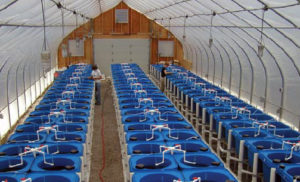
Atlantic salmon culture is one of the most successful global aquaculture enterprises. Production of Atlantic salmon in the United States is concentrated in the states of Maine and Washington, with Maine the country’s leading producer.
The northeastern U.S. is an ideal location for increased salmon production, but environmental issues, mandatory stocking of 100 percent native North American salmon to protect populations of federally endangered wild Atlantic salmon, and disease have impacted the economic viability of the industry.
In response to these problems, the U.S. Department of Agriculture (USDA) Agricultural Research Service developed the National Cold Water Marine Aquaculture Center in Orono and Franklin, Maine. The center’s mission is to enhance sustainable and profitable aquaculture production of coldwater marine finfish species like salmon.
Research activities
The initial research is an Atlantic salmon-breeding program utilizing North American stocks that focuses on growth and other economically important traits. Research objectives for the project address the genetic improvement of Atlantic salmon through a family-based selective-breeding program to develop improved North American Atlantic salmon lines for U.S. producers and consumers. Before its formation, no comprehensive research program in the United States supported the coldwater aquaculture industry, and no breeding program developed improved salmon.
Program facilities
The USDA program in Franklin is located adjacent to the University of Maine’s Center for Cooperative Aquaculture Research. Both facilities share infrastructure – water wells, power lines, and seawater pumping and storage – that was completed in 2005. When the research program began in 2003, it utilized two temporary greenhouses, one for culturing parr and the other for culturing smolts and subadults.
The construction of permanent research facilities begun in 2006 is now nearing completion. The 3,700-square-meter main USDA building includes office space, hygiene rooms, two research tank bays, and separate production systems for egg incubation, parr culture, smolt culture, grow-out and broodstock culture. The egg incubation systems include both large incubation trays and small jars for individual families. The facility can culture over 200 salmon families. Two research tank buildings outside the main building are used for additional projects.
Water management
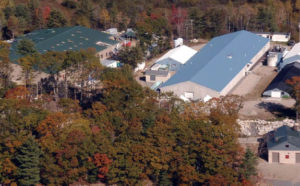
The research facility is supplied with water from four sources: filtered seawater from adjacent Taunton Bay that is treated with ultraviolet light, fresh well water, brackish well water with salinity of 2 ppt, and higher-salinity well water with salinity of about 6 ppt. The fish culture tanks are equipped with recirculation systems that utilize biological filtration, carbon dioxide stripping, supplemental oxygenation, ozonation, and ultraviolet sterilization.
Most systems also include chilling units to individually adjust water temperature to meet biological requirements. Temperature and oxygen levels are provided to feed controllers that dispense feed from robots traveling on rails above the culture tanks.
Overtopping water from the culture systems at the site discharges into a wastewater treatment building with microscreen drum filtration, untraviolet irradiation to disinfect the water, and a traveling belt screen to remove all eggs or fish from the discharge.
Fish production
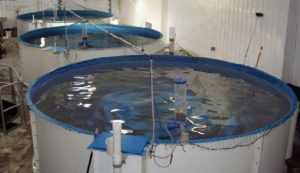
In 2003, the research program obtained eyed eggs for breeding from state, federal, and commercial hatcheries. The eggs were certified for disease-free status and North American origin by genetic testing. Individual families and pooled family groups were obtained from two St. John’s River sources and landlocked salmon stocks.
The program is currently culturing salmon from four consecutive year classes. Typically, eggs are disinfected upon arrival and incubated in separate hatching jars. After initiation of feeding, fish densities are equalized in 0.15-cubic-meter parr-rearing tanks and evaluated for early growth traits.
Performance evaluation
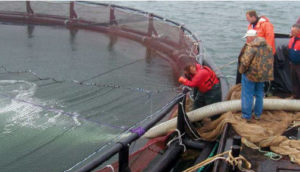
The young fish are pit tagged and vaccinated at 20 to 40 grams and stocked into 9-cubic-meter smolt tanks. Smolts are then stocked into sea cages in cooperation with industry partners and evaluated for growth, survival, and sexual maturity under commercial situations.
A nucleus of fish from each year class are maintained at the facility and cultured to sexual maturity. Following performance evaluations of the caged fish, a selected group will be spawned from the nucleus group at 4 years of age.
(Editor’s Note: This article was originally published in the March/April 2007 print edition of the Global Aquaculture Advocate.)
Now that you've reached the end of the article ...
… please consider supporting GSA’s mission to advance responsible seafood practices through education, advocacy and third-party assurances. The Advocate aims to document the evolution of responsible seafood practices and share the expansive knowledge of our vast network of contributors.
By becoming a Global Seafood Alliance member, you’re ensuring that all of the pre-competitive work we do through member benefits, resources and events can continue. Individual membership costs just $50 a year.
Not a GSA member? Join us.
Authors
-
William R. Wolters, Ph.D.
USDA/ARS National Cold Water Marine Aquaculture Center
33 Salmon Farm Road
Franklin, Maine 04634 USA[118,111,103,46,97,100,115,117,46,115,114,97,64,115,114,101,116,108,111,119,46,108,108,105,98]
-

Steven. T. Summerfelt, Ph.D.
Conservation Fund Freshwater Institute
Shepherdstown, West Virginia, USA
Related Posts
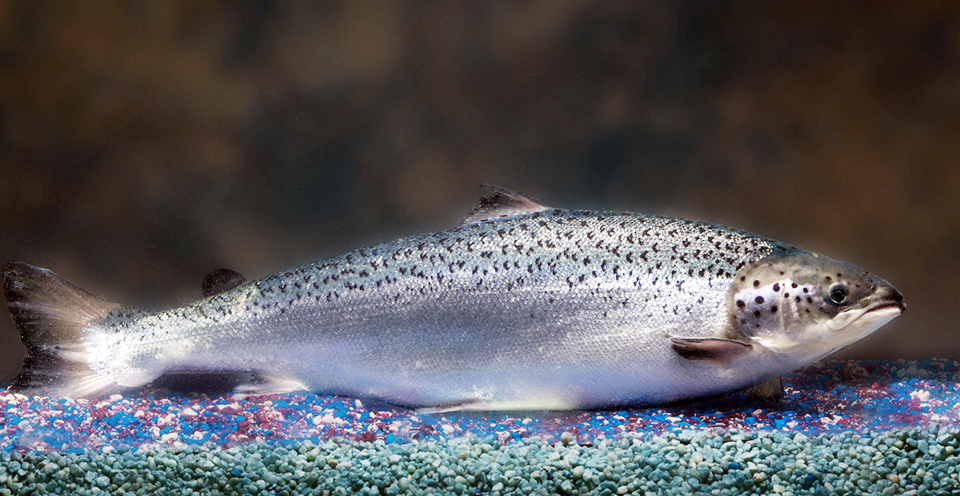
Intelligence
A brief look at genetically modified salmon
If approved by FDA, fast-growing genetically modified salmon will provide a safe and nutritious product similar to other farmed Atlantic salmon.
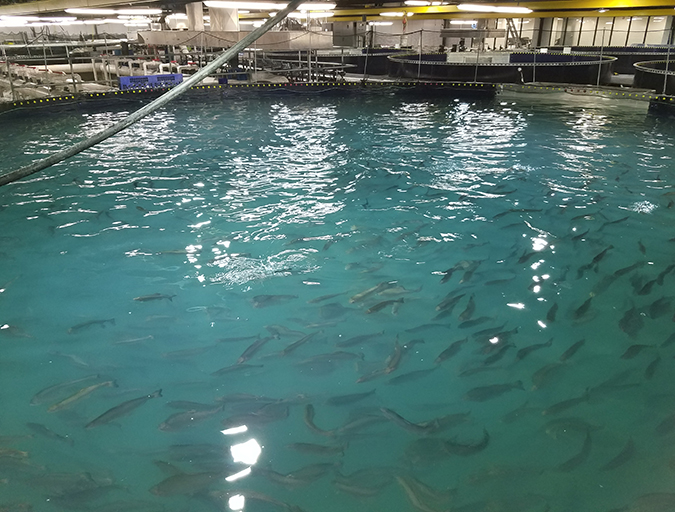
Intelligence
A land grab for salmon (and shrimp) in upstate New York
The operators of Hudson Valley Fish Farm see their inland locale as a pilot to prove that land-based fish farming, located in close proximity to major metropolitan markets, can be successful.

Responsibility
A look at integrated multi-trophic aquaculture
In integrated multi-trophic aquaculture, farmers combine the cultivation of fed species such as finfish or shrimp with extractive seaweeds, aquatic plants and shellfish and other invertebrates that recapture organic and inorganic particulate nutrients for their growth.

Aquafeeds
A new nutrient for aquaculture, from microbes that consume carbon waste
Biotechnology firm NovoNutrients aims to produce a line of nutraceutical aquafeed additives as well as a bulk feed ingredient that can supplement fishmeal. Its process includes feeding carbon dioxide from industrial gas to a “microbial consortium” starring hydrogen-oxidizing bacteria.


